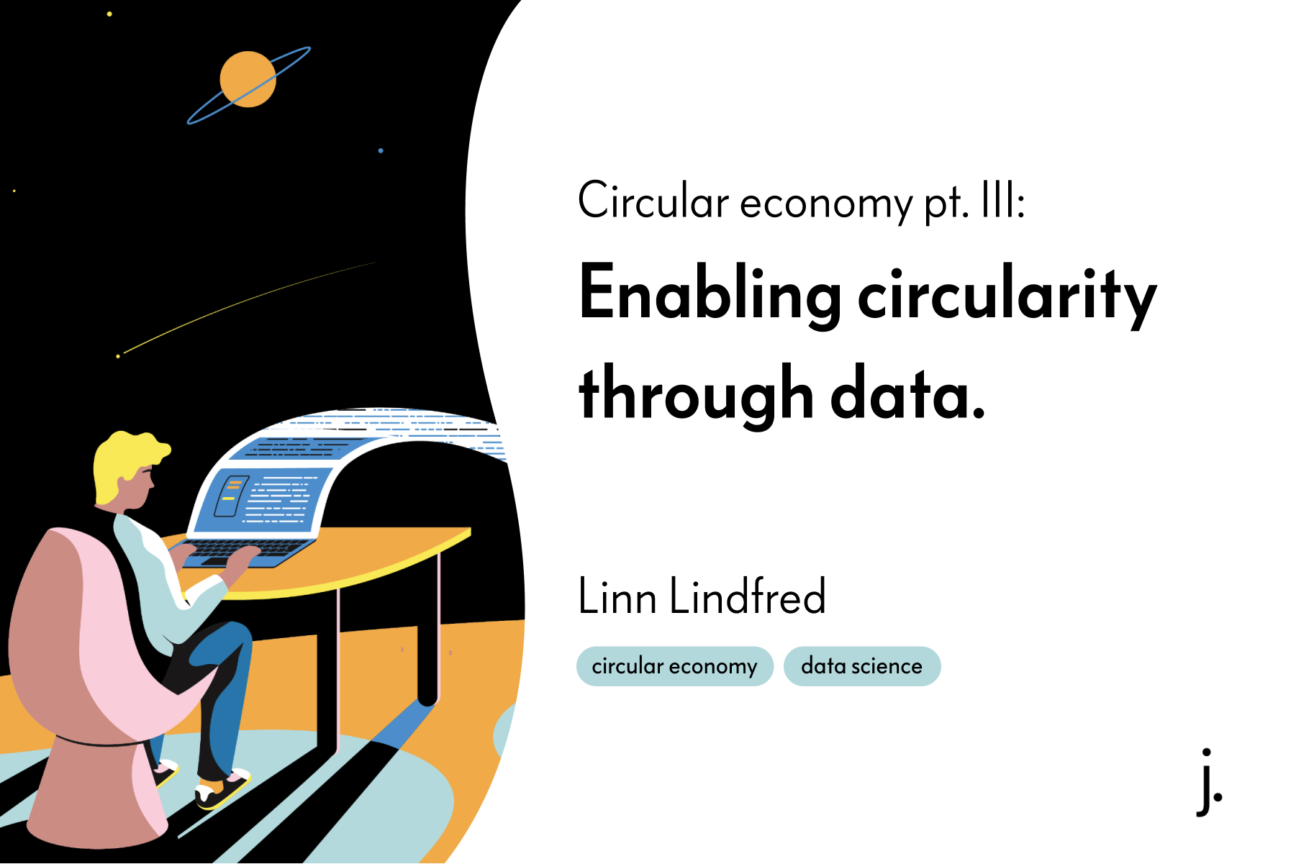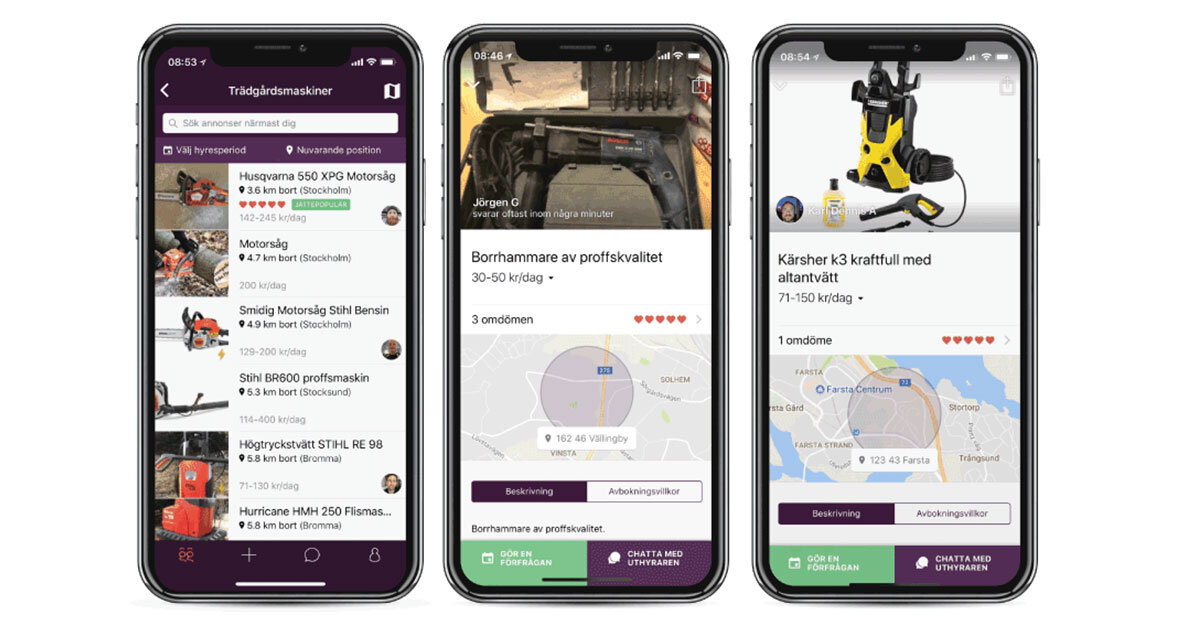In my latest blog post, I discussed how to design for circular economies. This post will focus on connected products, data science and its potential for reaching circularity.
The fundamental aspects of a circular business is that you design out waste and pollution as well as extraction of new resources by prolonging lifetime, intensifying use, increasing production efficiency and minimizing unnecessary consumption.
Making sure the product and its materials are used more and for a longer time is one of the goals in a circular economy. One example of how to make your products stay in use for longer is to repair them before they break and in the right way. At Jayway by Devoteam, we had a project where we enabled predictive maintenance for a large infrastructure company with the use of IoT and sensors. If the product itself can tell you beforehand that it is about to break or need maintenance, you can reduce downtime and reduce waste. From the insights you can also improve the quality of the product by adapting its design based on the data.
One way to increase the utility of products is to have many users of the same product and to find multiple use cycles. This could be achieved via a subscription service or usership-based business model. One company that tries to tap into a subscription model is Husqvarna. Husqvarna Battery Box makes it possible to rent tools via a mobile app, which increases utilization rates while simultaneously reducing the need to own tools. The startup company Hygglo offers a similar service but shares tools and other products by matching demand and supply amongst consumers.
In the scenario of renting out one product to many users, tracking and tracing your products becomes important. You need to be able to localize your product and you need to be able to provide information. You also need to provide the correct pricing depending on the current market, the product’s status and previous use. Lot’s of data streams are necessary and could be analyzed with the use of Machine Learning.
However, the question is whether or not these solutions will be able to scale. Using digital technology does not, in and of itself, lead to scaling if consumer demands are not met. Since people are lazy and seek convenience, most of us will choose the path of least resistance and would rather have our own drilling machine available at all times than having to trouble ourselves with collecting, renting, using and returning one every time we want to drill a hole. In order to scale up these initiatives, they need to be as convenient as possible or, at the very least, more convenient than the alternative. Board of Innovation argues that:
“We will need companies that go all-in on frictionless experiences to shift our lives toward a sustainable future.”
By launching its service Clas Fixare, Clas Ohlson has arguably attempted to create such a frictionless experience. Instead of renting you a drill, Clas Fixare comes to your home and drills the hole for you, something that some people might consider the most convenient option. However, for that service to work, you have to transport the person and the tool to the specific place, which could be both time consuming and of course CO2 heavy. Wouldn’t an easier, more environmentally friendly and convenient alternative have to be a locally based neighbourhood service for tool-sharing?
Another idea is mentioned in a study by Chalmers University of Technology. By collecting data on how, when and where products are being used and analyzing it with the use of Machine Learning, companies and individuals renting out products could plan ahead to be in the right place, at the right time and with the right product. For example, gathering location data on areas with a lot of houses with large hedges and combining that with data on how often, under which weather conditions and during which seasons these hedges are typically trimmed, you could plan to be in the right area, at the right time, renting out the right tools.
The use of data in this way does not only optimize these business’ operations, it also has the ability to grow revenues and improve the bottom line, while simultaneously helping the environment by reducing the number of people owning tools they do not really need to own. Again, this would not be possible without the use of digitalization. Although, there is an obvious issue with this solution. In terms of data science, it is crucial that we establish ways to ensure that no personal data is being collected without approval.
Closing the loop
One thing that enables the reuse and recycling of materials and components is information. Information about what the product contains and how to value it is crucial in order to have any chance of handling the product in the right way. There are already many examples of companies that have begun to track and trace this information in order to close the loop of their businesses.
The biggest shipping company in the world, Maersk, has digital passports on their ships to keep track of each and every component of the ship at all times. Madaster is offering that same service but for buildings, making it possible for you to know all of the different materials each building is made of and to gather all that information in one place. This information also makes it possible to identify and track the value potential throughout the building cycle. SSAB gives their steel a digital identity in order to keep track and trace information of its products.
These companies have full access to information about each unique product, what they are made of, how they are composed and how they can be decomposed. At their end-of-life, when the products are taken back to the producer, these companies can use Machine Learning to analyze the data. In this way they can make informed decisions of whether to sell, recycle or reuse the materials based on chosen parameters such as sustainability, cost and efficiency. For example, Microsoft uses machine learning to sort and derive methods for how to handle servers in the most efficient way at their end-of-life stage as part of their zero-waste strategy 2030. Seeing products as material banks is a way to mitigate supply chain risks, decrease costs and decrease the extraction of new resources.
Another industry that is adopting these technologies and this mind-set is the fashion industry. EON’s CircularID strives to connect products in the clothing industry, giving each garment a unique identity through a digital material passport. The goal is to identify and manage the products throughout their life-cycles (see picture below). In a similar way, TrusTrace tracks information throughout the supply chain, i.e the environmental footprint of products and logs them in a blockchain. They also offer a way to communicate the information to the customer via QR codes.
The Circular ID by Eon. Picture from Eon
Preserve resources
Another important aspect of circularity and to secure our future lives on this planet, is to preserve what we need to consume such as water and energy. In the living lab Pecan Street, they have managed to transform old, analog water meters into IoT devices that can learn how water is used in real-time and detect hidden water leaks. They also communicate the data to the user via an app to enable a change in behavior. Humans are not born evil, but when we are not aware of the impact of our actions, we tend to make decisions based on convenience more than anything else.
Solar energy is an exponential technology that is becoming available to more and more individuals. At Jayway, we have helped SVEA solar with its digital platform. This allows users to monitor the solar energy being produced by their own solar panels, their consumption over time, and the energy that is purchased from or sold to utility companies. We are also in the process of building support for chargers for electric cars, where we create the integration to collect information on, for example, temperature, charge level, and speed. The long term goal is to provide real-time electricity prices in the app so that the user can choose to charge the car at the “cheapest time” and also start and stop charging directly from the app. In this way, it becomes both easier and cheaper to use solar energy.
We tend to come back to what is mentioned in my previous blog post, matching an emerging market need (either pushed by the planet, consumers or laws and regulations) with a new technology and a circular business model is a recipe for scalability, sustainability and success.
As discussed, data science is important for a circular economy to evolve. The previously mentioned study by Chalmers University of Technology, investigated the potential impact of using AI to enable circular economy. Through literature reviews and expert interviews they found that AI can play an important role in the below areas:
-
Design and development of circular products, components and materials
-
Circular business models
-
Circular technique and infrastructure
-
Traceability
However, the study shows that the most important aspect in order to achieve the intended results is access to relevant data. It also stresses that the two areas of circular economy and AI need to be intertwined and that we need to form cross-border cooperation between the two competencies. That is yet again a reason for digital bureaus and creative technologists to attract talents in both of these fields.
Even though this October-blog series is full of examples where digital tools generate positive impact, needless to say, digital tools have the backside of sometimes enabling the opposite, negative impact. Instead of paving the way for sustainability and circularity, digital tools could foster more consumption and production, thus speeding up the pace of the linear economy and society going in the wrong direction. Therefore, it is crucial that those working with digitalization make sure that they understand the impact of their solutions in more ways than from just an economic or business point of view. It is important to make sure that you consider sustainability trade-offs and alternative business models. It is our responsibility to push the digital solutions towards enabling circularity and not speeding up the unsustainable consumption patterns created by the linear economy.
If more companies and industries would implement a circular mindset and achieve scalable solutions with the help of digital tools, we are on the right track towards establishing prosperous industries that function within our planetary boundaries. That is what these three blog posts have been about. Hopefully, I have managed to persuade you that it is possible to transform and scale circular business models by showing you examples of companies merging digitalization and circularity.
If you have any questions, do not hesitate to contact me. If you want to learn more about digitalization and circularity, download my chapter “Digitalization, circular economy and the future of labor: how circular economy and digital transformation can affect labor”.



